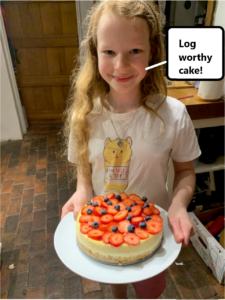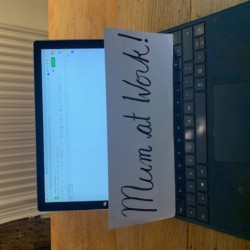November 20, 2010: I was walking to the post office with Ali, musing nostalgically that this is our last month of constant mum-and-son togetherness before the Yuletide arrival of his baby sister, when a woman walked past, pushing a Bugaboo. Ali burst into tears, blurting in anguished outrage, “EVERYONE has their baby already except ME!”
January 11, 2013: “It’s time to change your nappy,” I told Isla. “I’m very busy,” she replied, not deigning to look up from her colouring table. Mirror, Mirror on the wall, where did she learn that turn of phrase??
These unforgettable moments would be all too soon forgotten were it not for my so-called Sprog Log — a pedestrian-looking spreadsheet where I add a few lines each day about my kids’ adventures in growing up.
With its account of their inventions and neologisms, triumphs and life lessons — and some losses, along the way, too painful to revisit lightly — my Sprog Log is my most treasured possession.
I offer sprog logging here as a low maintenance way to capture, cell by cell, a mosaic of childhood and youth.
Getting Started
You can set up a Sprog Log in less time than it takes to read this post. Mine is a Google Docs spreadsheet with columns for the date, a subject heading and the kids’ names. As I provide access to their grandparents, I’ve allocated a column for comments, guest-book style.

Storing my Sprog Log on Google Docs allows me to update it on any device, on the go, and to provide access to my select but devoted readership.
Access All Memories
A key question for any Sprog Logger is: Who gets access?
In addition to my husband, I invited the kids’ grandparents to share the journey. (I started the log, over ten years ago, as a quick way to update them about their grand-kids, and only later realised that the log was actually a gift to myself).
I do not provide access to the kids for now, though they know it exists — “This is going in the log,” is a stock phrase in our family. I will give them the password on their 18th birthdays, along with the car keys to their lives.
Knowing that I am writing for their future selves means I compromise a bit on candor. In particular, I reserve most of my perennial parental worries for my journal or private correspondence. It comes down to a choice between privacy and relationship building. Decide what you need most.
 Why Keep a Sprog Log?
Why Keep a Sprog Log?
With a decade of logging under my belt, I can’t think of a five minute daily investment that yields richer dividends. I would never maintain a family blog or scrap booking project — hats off to those who do — but five minutes a day is a sustainable commitment.
Being the self-appointed family historian challenges me to observe my kids more closely, and savor the details. Logging the memories onto a spreadsheet helps me lock them in my brain. I also suspect that the daily imperative to produce content spurs me to make the most of my moments with the duo, seeking to bring more fun, inventiveness, conversation and warmth into our lives. If I make it happen, I get to write it down.
The log fosters cross-generational connection — all the more for the times when an entry prompted my hands-off mother-in-law (RIP) to ring and remind me to, “STOP pressuring those kids.”
The log is another way to let my children know just how important they are to me. Significance and belonging are the primary developmental needs of childhood, according to Adlerian psychology. I believe that the Sprog Log contributes to both.
Further, as an author, the log is my war chest of story ideas and prompts for my empty nest years ahead.
Most importantly, perhaps, this date-with-self gives me time to reflect on their development, and my role as their prent. When I yelled at my son for waiting until bedtime to announce that he had no school trousers left (having ripped his last pair that day) my daughter burst into tears, blaming herself for neglecting to sew the other ripped pairs piled in her “mending basket.” Logging about the incident prompted me to initiate a serious conversation with her, the next day, about personal responsibility (mine, for lashing out and his, for organising his kit). It raised my awareness that in the future, I may need to help her navigate her discomfort with others’ distress and also, try harder to keep my temper in check.
Tips and Tricks
- Pick a regular time of day to log — e.g., before brushing teeth at night — or set a phone alarm to remind yourself. What time suits you best?
- Figure out a way that makes it easy and appealing for you. I like the accessibility and searchability of a spreadsheet but you might prefer the physicality and tactility of a notebook, or some other approach.
- Don’t worry about clever phrasing or wit. The key is to get something down. You can always revise later.
- Providing access to eager readers, such as grandparents, can strengthen one’s sense of purpose. Not only do they cheer me on, but they hold me accountable, if I skip a day or two.
- Give yourself the luxury of reading it over every now and then, to celebrate the growth in your children and everything you’ve experienced together.

Other Ways to Record Childhood
Logging isn’t for everyone. Here are some other options for building a family record:
- Get a monthly or weekly calendar with a large grid. Draw a doodle in each square to remind you of something that happened that day.
- Set up a special email account and use it to send your child periodic notes and photographs. When they grow up, they can inherit the password.
- Keep a record of photographs and anecdotes on Facebook and compile them into an booklet.
- Send your child an annual letter describing the year’s special events and developments. Keep a copy in an album along with an iconic photograph capturing the spirit of the year.
Sprog Log Template
Would you like to try sprog logging?
For a copy of my Sprog Log template, contact me at joanna.norland@gmail.com.



No comments yet.